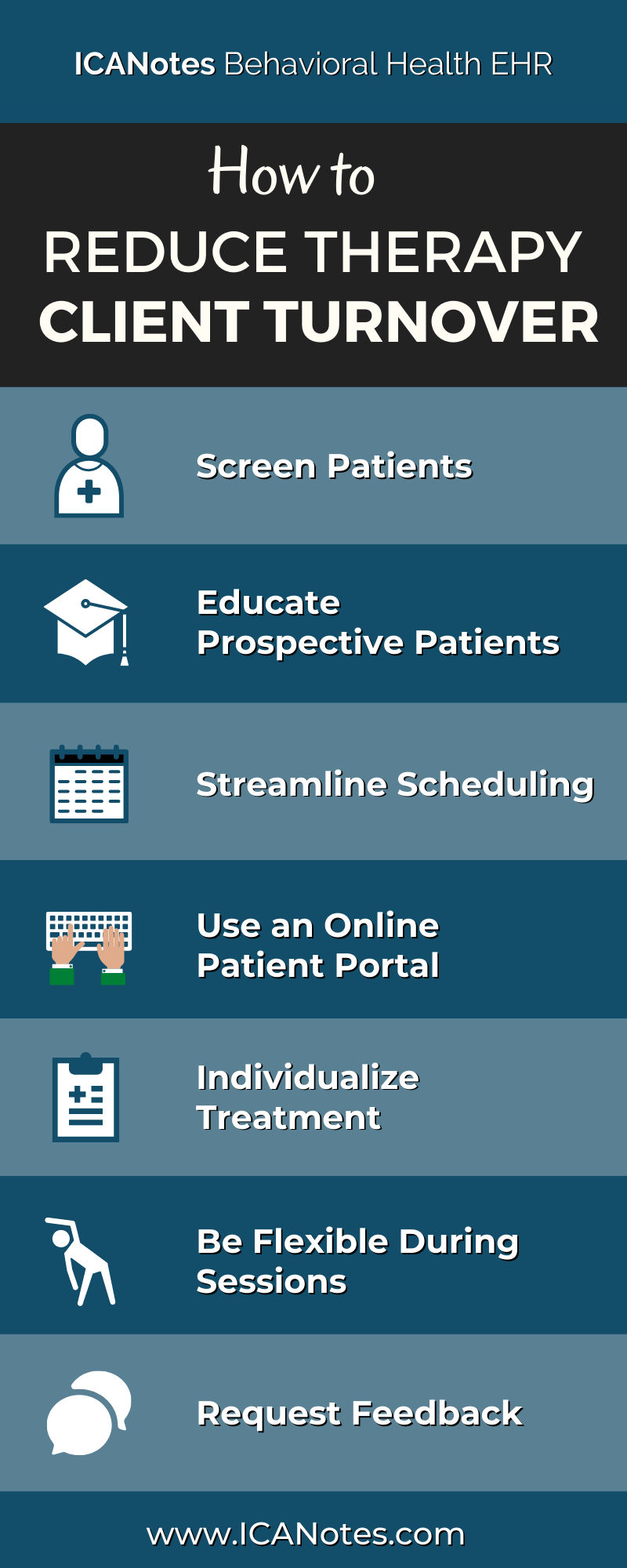How to Reduce Your Client Turnover Rate
The struggle to retain clients is something most mental and behavioral health professionals have in common. Consistency in attendance among your clients is necessary for their treatment to be successful, and steady revenue streams help keep your business running smoothly.
Client turnover can occur for a range of reasons, some of which will be completely out of your control. Being able to identify why clients leave and what you can do about it are essential for learning how to reduce client turnover.
Table of Contents
- What Is Patient Turnover?
- What Causes a Client to Leave?
- The Importance of Patient Retention
- Seven Ways to Reduce Therapy Client Turnover
What Is Patient Turnover?
If a mental or behavioral health doctor has a high patient turnover, or “churn,” it means they are acquiring and losing clients at a consistent rate. A client may drift away slowly, missing an appointment now and then, only to stop contacting you altogether, or they may abruptly cut off contact with little or no warning. Either way, losing a client can be a blow to your business.
Unfortunately, patient turnover is a common phenomenon. Client turnover rates are highest with patients in their 20s, and patients who are seeking treatment for personality or eating disorders and an estimated one in five clients drops out of psychotherapy before their treatment is complete.
The more inexperienced a clinician is, the greater the risk of high turnover. Some novice clinicians have reported a dropout rate of up to 75 percent, which can dramatically impact a new practice through revenue and reputation loss.
What Causes a Client to Leave?
To reduce your turnover, you first have to understand what drives it. There is often more than one factor involved in a patient’s decision to break off a relationship with their mental health provider. However, the most common reasons are:
1. Financial Issues
One of the most common and unfortunate reasons for turnover is a financial barrier. The cost of insurance continues to increase each year, leading more and more Americans to forego it altogether or settle for cheaper plans with less coverage. Without insurance, many patients may be able to attend one or two sessions to address a crisis but are forced to discontinue treatment when their funds run out.
Alternatively, patients may have insurance that provides inadequate coverage, such as limiting counseling to an arbitrary number of sessions. Once those sessions are up, and they have to pay out of pocket, patients may be unable to continue. Beyond developing a pro bono or charity service, there is nothing you can do to stop turnover related to finances. However, you can make the best use of your time with the client by investigating how many sessions insurance will cover.
2. Not Committing to Recovery
Many people who sign up for therapy are not aware of the work it entails. They may think of therapy as a “quick fix” and feel disillusioned when the commitment is greater than they realized.
It takes time and some degree of trial and error to see results from therapy, and there is no guarantee that any medication prescribed will work quickly or effectively enough to satisfy a patient who is not willing to show up to all their appointments and do the work.
3. Lack of Progress
Even when the client has appeared to be dedicated to their treatment for a certain period of time, they may plateau in progress for a number of reasons. Perhaps they have experienced a setback at work or in a relationship, or have simply lost steam. When a patient starts to feel like they aren’t improving, they may believe they are no longer getting value from their treatment. This can lead to them switch to a different provider or stop treatment altogether.
4. Poor Customer Service
Although you’re a health professional, you still have to consider the level of customer service you are providing your clients. Are you difficult to get a hold of? Do you wait multiple days to respond to messages? Do your clients have to spend a significant amount of time in the waiting room before being seen?
The easier you can make the whole process for your clients, the more engaged they will be when it’s time to start each session, and the less likely they will be to discontinue treatment due to a buildup of minor inconveniences.
5. Poor Patient-Therapist Fit
Psychotherapy requires a good deal of vulnerability on the part of the client, and to be successful in treatment, you must develop a base level of rapport. Sometimes, personalities just don’t mesh well together, and the patient simply may not feel comfortable sharing their issues with you.
Other times, there may be something you are doing in your sessions that makes your patients uncomfortable or reluctant to share. Countertransference, where the therapist inadvertently transfers feelings onto the client, can cause patients to disengage and ultimately turn over. Learning and watching out for the warning signs of countertransference can help customer retention.
In other situations, your experience may not align with patient needs. For example: If you have a patient seeking counseling for child behavior and you don’t have much experience with kids in therapy, it may be more appropriate for you to refer the patients to a colleague or another professional who specializes in child psychology or another specialty more closely related to the issues they are experiencing.
The Importance of Patient Retention
You can’t treat clients effectively if they cut off treatment or become inconsistent in their attendance to your sessions. For clients seeking treatment for acute trauma that has recently occurred, it may take only a few sessions to determine and meet their goals. For more complex trauma and ongoing mental disorders, treatment may need to extend for multiple months or even years to keep the patient stable.
If you are a prescribing clinician with patients who need to be monitored on long-term medication, customer retention is even more important, as failure to adhere to a medication plan can result in the return of highly disruptive or potentially dangerous symptoms.
From a business point of view, a high client turnover rate can hurt your success. Every client who discontinues treatment for reasons within your control is a patient who won’t be leaving you positive online reviews and won’t recommend friends or family to you. Both client reviews and word of mouth are essential in building up your practice and attracting more clients, so keeping turnover in check is crucial in practices that are growing or already established.
Seven Ways to Reduce Therapy Client Turnover
Just as there are several reasons patients withdraw from treatment, there are several ways you can improve the patient experience and boost your retention rates — these include:
1. Screen Patients
It’s sometimes hard to get comfortable with the idea of being more selective with your patient acquisition process. It’s not about rejecting patients in need — it’s about determining whether you and the patient will be a good fit. Screenings for a history of trauma, mental illness and substance abuse are common among behavioral and mental health professionals.
If a patient is not a good match for any reason, you should give them a referral to a professional who can better serve their needs. For example, if you are an LPC and a prospective patient has schizophrenia which they’ve received medication for, it makes the most sense to refer them to a psychiatrist who can fulfill their counseling and medication needs.
2. Educate Prospective Patients
The importance of patient education cannot be understated. You and your patient need to be on the same page regarding what treatment entails. Using a screening process will help you gather more information about the patient before your first session, which you can use to present a possible road map for treatment.
It’s a good idea to prepare an explanation of your methods and expectations in a document format, so your patient can see a visual representation of the commitment they will need to make for successful therapy.
3. Streamline Scheduling
You’re a busy professional yourself, so you understand how difficult it can be to squeeze in all the various appointments you have on your plate. However, therapy typically comes with a lot more emotional tension than an oil change or routine dental appointment, meaning minor inconveniences become a bigger reason to skip or continually reschedule sessions. Consider the following questions when evaluating your current scheduling practices:
- Do patients have to call to schedule an appointment?
- How promptly are phone calls returned?
- Do you provide confirmation of scheduled appointments?
- Do you offer the option for evening appointments?
- How long do patients typically wait before being seen?
Providing more flexibility in your operating hours and more options for scheduling can make patients feel more confident about their appointments. Reducing wait times by having patients fill out forms ahead of time and minimizing overbooking helps reassure patients you’re engaged and committed to their treatment.
An electronic health record (EHR) system with a scheduling feature can also keep track of patient no-shows and cancellations for better tracking.
4. Use an Online Patient Portal
The patient portal is an excellent way to give patients more control over their mental health care. A portal like the one used in ICANotes offers a variety of features that empower patients to:
- Complete intake forms online.
- View information about prescribed medications and request refills.
- See and confirm upcoming appointments.
- Request email reminders about appointments.
With these features, patients will have a more active role in their attendance, potentially increasing their engagement with treatment and reducing attrition.
5. Individualize Treatment
Every patient who walks through your doors has a different story and different treatment needs. It’s your job to assess individual needs and provide suitably individual treatment based on what you find out in the screening process and initial therapy sessions.
Committing to viewing each patient through the lens of their unique needs lets your patients know you’re taking their preferences and needs into account rather than trying to shoehorn them into a particular template during treatment.
6. Be Flexible During Sessions
Once you have conducted one or two therapy sessions with a new client, it’s tempting to try and set your treatment plan in stone. However, flexibility and addressing new issues as they come up is key to client retention. People’s priorities may change, or they may encounter a setback that draws their immediate concern. If a client comes to you for treatment of obsessive-compulsive disorder (OCD), you may be able to form a treatment plan rather quickly.
Your first goal may be to investigate the client’s initial experiences with the disorder, but find that the client is more concerned with learning coping mechanisms first. In this case, it’s important to respect the client’s wishes to improve their functionality before trying to delve into the roots of their disorder.
Build some flexibility into your sessions by asking the client what their immediate goals are. Not everyone will have a clear idea of their needs, but offering the opportunity for the client to guide therapy can lead to unexpected breakthroughs and prove your commitment to improving their lives in meaningful ways.
7. Request Feedback
Any business that provides a service to people should regularly collect and incorporate feedback from customers. While you likely have some idea of how your sessions are going with a particular client, there may be things you could do better that you hadn’t considered before asking for feedback.
It’s a good idea to make up a feedback form you can have clients fill out after a certain point, such as after their second or third session. Feedback from patients can help you make overarching changes like reducing your wait times, but it can also help you individualize treatment.
For example, a patient may not have much to say about your scheduling practices, but might feel more comfortable using a form to let you know that you make more eye contact than they would like. Whatever the nature of the feedback you get, you can use it to reduce therapy client turnover.
Improve Patient Retention With ICANotes
An EHR can have a significant role in reducing your client turnover rate if you choose the right one. ICANotes is designed specifically for mental and behavioral health clinicians and includes practice management features that make it easier to keep clients engaged with therapy. With ICANotes, you can improve scheduling, manage documents and communicate electronically with patients.
The ICANotes patient portal gives you the option to include online intake and electronic forms to make the initial process of beginning therapy easier on your patients, while providing them with relevant information about their own health, like prescriptions and upcoming appointments.
Retaining patients in therapy isn’t just good business sense, it’s the best way to make sure clients benefit from their full course of treatment. By examining your practices and streamlining your processes with ICANotes, you can minimize turnover while improving your quality of care.
For more resources on client turnover and retention, contact ICANotes at 866-847-3590 or fill out our contact form. We’re happy to answer your questions and explain how the tools available in ICANotes can help reduce patient turnover.
Check Out The Treatment Plan Webinar!
Related Posts
Mental & Behavioral Healthcare Billing: How to Maximize Your Reimbursement Rate
How Amazon’s Alexa Can Be Used in Clinical Practice Settings







